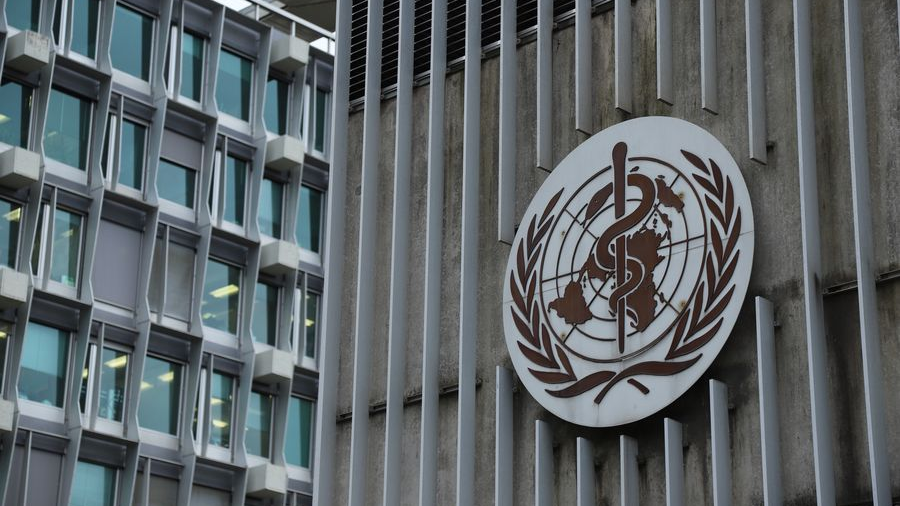
The headquarters of the World Health Organization in Geneva, Switzerland, January 30, 2020. (Photo: Xinhua)
On December 17, the WHO said that China will be welcoming an international COVID-19 investigating team in January, which it is leading. The team of 12-15 international experts will examine the evidence, undertake human and animal sampling, which have been collected by Chinese researchers and come up with policy recommendations and conclusions in light of the findings.
This statement and emphasis placed on evidence collection marks a sharp departure from the vitriolic tirades emanating from Washington claiming that China is averse to international investigations, lacks transparency in terms of explaining the exact origins of the virus, and the central government has withheld statistics from the international community. The fact that the mission will be going to Beijing in the first week of January hints at key nuances that have been largely ignored by certain Western capitals while making false claims on both the origins of the virus and China's narrative on dealing with it.
The nuance is that there is a difference between launching state-sponsored propaganda campaigns against another sovereign state and pushing for joint cooperation to trace the origins of a quagmire based on facts and evidence. The WHO has chosen the latter, given its status as an integral institution of the UN. It is the same international body castigated by the Trump administration for its perceived coziness with the Chinese government with threats of defunding the organization and questioning its efficacy to follow.
Attempts to malign China on COVID-19 and highlighting subjects of national significance such as Hong Kong has been the standard practice of the U.S., with coercion and provocations trumping efforts to actually embark upon fact-finding missions. Skepticism over U.S.-led inquiries into China's territory, which have resulted in diplomatic spats, is well-founded.

Medical workers pose for photos after seeing cured patients off at the Wuchang temporary hospital in Wuhan, central China's Hubei Province, March 10, 2020. (Photo: Xinhua)
China welcoming the investigating team's visit demonstrates how China is also a victim of the pandemic as any other sovereign state, given that thousands of casualties were reported amid infections in the world's most populous country.
There is great regard for joint tracing efforts given that Chinese authorities consider that the origins of COVID-19 are ambiguous and cannot be categorized as a "Chinese" or "Wuhan virus" as mentioned by the Trump administration repeatedly. There is no aversion to multilateral institutions such as the WHO establishing conclusive evidence or data sharing and preventive measures by visiting China. Therefore, criticisms regarding China's unwillingness to cooperate with certain Western capitals are hollow.
Even at the societal level, Wuhan residents have expressed optimism at the planned visit of the WHO team. One resident surnamed Wan said that he welcomed the incoming team and was curious to find out about the exact origins of the virus even if there is conclusive evidence that the source of the virus is actually traced from his city. Similarly, a real estate developer named Liu Qin said that he was not afraid of investigations, given that the city and the authorities have handled the pandemic situation well.
Both the Chinese people and the central government are not in denial about the origins of the virus as purportedly stated by the U.S. administration but are desirous of witnessing an impartial, objective and fact-based assessment given that China shares equal genuine concern with the rest of the international community over curbing a pandemic which has killed millions of people.
The broader scientific community has maintained that COVID-19 did not originate from Wuhan, and some studies have indicated that the virus was already a potent threat prior to it reaching the Huanan Seafood Market in the city. It is even possible that the virus had multiple transmission routes. In light of these ambiguities and research gaps, premature conclusions on the origins of the virus lack merit.
Much of Beijing's efforts in curbing the virus, while appreciated by the WHO, have largely been sidelined by the Trump administration. This upcoming visit also acts as an opportunity to showcase how well the city of Wuhan has done in battling the virus, which has wreaked havoc in cities across Europe and North America.
As numerous Western publications have published stories which are nothing more than undue provocations, China has sought a different route of evidence collection and tracing efforts that underline its commitment towards transparency on COVID-19.


